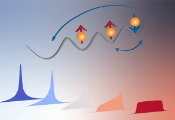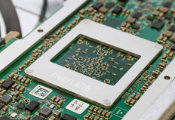Quantinuum Researchers Make a Huge Leap Forward Demonstrating the Scalability of the QCCD Architecture, Solving the “Wiring Problem”
March 5, 2024 -- Quantum computing promises to revolutionize everything from machine learning to drug design – if we can build a computer with enough qubits. The issue of scaling is arguably one of the hardest problems in the field at large: how can we get more qubits, and critically, how can we make all those qubits work the way we need them to?
A key issue in scaling is called the “wiring problem”. In general, one needs to send control signals to each qubit to perform the necessary operations required for a computation. All extant quantum computers have a hefty number of control signals being sent individually to each qubit. If nothing changes, then as one scales up the number of qubits they would also need to scale up the number of control signals in tandem. This isn’t just impractical (and prohibitively expensive), it also becomes quickly impossible - one can’t physically wire that many signals into a single chip, no matter how delicate their wiring is. The wiring problem is a general problem that all quantum computing companies face, and each architecture will need to find its own solution.
Another key issue in scaling is the “sorting problem” - essentially, you want to be able to move your qubits around so that they can “talk” to each other. While not strictly necessary (for example, superconducting architectures can’t do this), it allows for a much more flexible and robust design – it is the ability to move our qubits around that gives us “all-to-all connectivity”, which bestows a number of advantages such as access to ultra-efficient high density error correcting codes, low-error transversal gates, algorithms for simulating complex problems in physics and chemistry, and more.
Quantinuum just put a huge dent in the scaling problem with their latest result, using a clever approach to minimize the number of signals needed to control the qubits, in a way that doesn’t scale prohibitively with the number of qubits. Specifically, the scheme uses a fixed number of (expensive) analog signals, independent of the number of qubits, plus a single digital input per qubit. Together, this is the minimum amount of information needed for complete motional control. All of this was done with a new trap chip arranged in a 2D grid, uniquely designed to have a perfect balance between the symmetry required to make a uniform trap with the capacity to break the symmetry in a way that gives “direction” (eg left vs right), all while allowing for efficient sorting compared to keeping qubits in a line or a loop. Taken together, this approach solves both the wiring and sorting problems – a remarkable achievement.
Stop-motion ion transport video showing loading an 8-site 2D grid trap with co-wiring and the swap-or-stay primitive operation. Single Yb ions are loaded off screen to the left, and are then transported into the grid top left site and shifted into place with the swap-or-stay primitive until the grid is fully populated. The stop-motion video was collected by segmenting the primitive operation and pausing mid-operation such that Yb fluorescence could be detected with a CMOS camera exposure.
Stop-motion ion transport video showing a chosen sorting operation implemented on an 8-site 2D grid trap with the swap-or-stay primitive. The sort is implemented by discrete choices of swaps or stays between neighboring sites. The numbers shown (indicated by dashed circles) at the beginning and end of the video show the initial and final location of the ions after the sort, e.g. the ion that starts at the top left site ends at the bottom right site. The stop-motion video was collected by segmenting the primitive operation and pausing mid-operation such that Yb fluorescence could be detected with a CMOS camera exposure.
The team used this new approach to demonstrate qubit transport and sorting with impressive results; demonstrating a swap rate of 2.5 kHz and very low heating. The low heating highlights the quality of the control system, while the swap rate demonstrates the importance of a 2D grid layout – it is much quicker to rearrange qubits on a grid vs qubits in a line or loop. On top of all that, this demonstration was done on three completely separate systems, proving it is not just “hero data” that worked one time on one system, but is instead a reproducible, commercial-quality result. Further underscoring the reproducibility, the data was taken with both Strontium/Barium pairs and Ytterbium/Barium pairs.
This demonstration is a powerful example of Quantinuum’s commitment and capacity for the full design process from conception to delivery: our team designed a brand-new trap chip that has never been seen before, under strict engineering constraints, successfully fabricated that chip with exquisite quality, then finally demonstrated excellent experimental results on the new system.




































